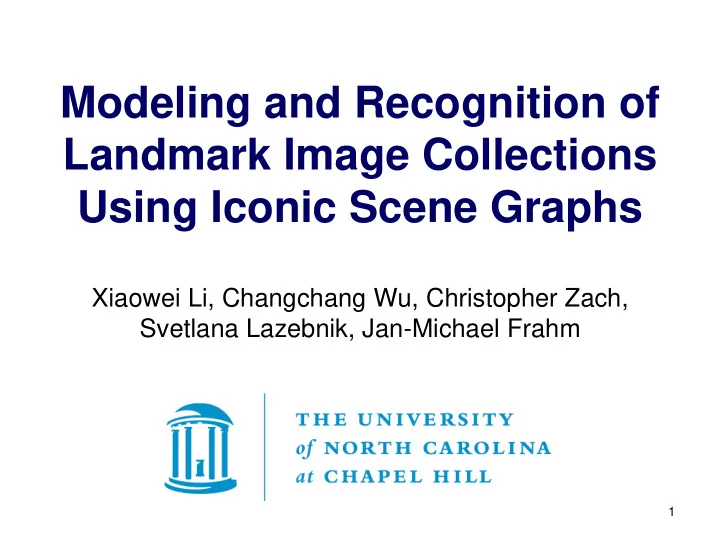

Modeling and Recognition of Landmark Image Collections Using Iconic Scene Graphs Xiaowei Li, Changchang Wu, Christopher Zach, Svetlana Lazebnik, Jan-Michael Frahm 1
Motivation • Target problem: organizing community photo collections of famous landmark sites such as the Statue of Liberty • We present a unified system for dataset collection, scene summarization, 3D reconstruction, and recognition for landmark images • Approach: integrate 2D recognition and 3D structure-from-motion techniques for an efficient and scalable solution 2
Summary of approach 1. Appearance-based clustering • Run k-means clustering with gist descriptors (Oliva & Torralba, 2001) to find groups of images with roughly similar viewpoints and scene conditions 2. Geometric verification of clusters • Perform feature-based geometric matching between a few “top” images from each cluster • Select an iconic image for each cluster as the image with the most inliers 3. Construction of iconic scene graph • Perform geometric matching between every pair of iconic images • Create an edge for every pair related by a fundamental matrix or a homography 3
4. Tag-based filtering • Eliminate semantically irrelevant isolated nodes of the iconic scene graph 5. Structure from motion • Run graph cuts to break iconic scene graph into smaller components • Perform SFM separately on each component. Use a maximum-weight spanning tree to determine the order of incorporating images into the 3D model • Merge component models using geometric relationships along edges that were originally cut • Enlarge models by registering non-iconic images 6. Recognition • Register a new test image to the iconics using gist or vocabulary tree matching (Nister & Stewenius, 2006) followed by geometric verification 4
Overview Clustering Iconic images All images with gist, intra-cluster Pairwise matching of verification iconic images Iconic scene graph Graph SFM cut Reconstructed Components of iconic components scene graph 5
Iconic scene graph for browsing • Level 1: components of iconic scene graph • Level 2: iconic images belonging to each component • Level 3: images inside the gist cluster of each iconic Level 1 Level 2 Level 3 6
Statue of Liberty results Originally: 45284 images 196 iconic images Tokyo Las Vegas New York Registered images in largest model: 871 Points visible in 3+ views: 18675 7
Statue of Liberty evaluation Modeling Testing Unlabeled images: 42983 1092 images Labeled images: 2301 Stage 1: gist clustering Stage 2: per-cluster geometric verification Stage 3: per-image geometric verification Stage 4: tag-based filtering 8
Notre Dame results Originally: 10840 images 105 iconic images Registered images in largest model: 337 Points visible in 3+ views: 30802 9
Notre Dame evaluation Modeling Testing Unlabeled images: 9760 1044 images Labeled images: 1080 Stage 1: gist clustering Stage 2: per-cluster geometric verification Stage 3: per-image geometric verification Stage 4: tag-based filtering 10
San Marco results Originally: 43557 images Registered images in largest model: 749 Points visible in 3+ views: 39307 11
San Marco evaluation Modeling Testing Unlabeled images: 38332 1094 images Labeled images: 5225 Stage 1: gist clustering Stage 2: per-cluster geometric verification Stage 3: per-image geometric verification Stage 4: tag-based filtering 12
Computing Iconic Summaries for General Visual Categories Rahul Raguram and Svetlana Lazebnik To appear at the First IEEE Workshop on Internet Vision (in conjunction with CVPR 2008) 13
Motivation • We want to obtain complete, concise, and visually compelling summaries of image query results for general (and possibly abstract) categories • At present, photo sharing websites such as Flickr don’t do a very good job of this Top 24 “most relevant” Flickr results for the category “apple” 14
Summary of approach • Our definition: an iconic image is a high-quality representative of a group of images consistent both in terms of appearance and semantics • Finding iconic images: • Cluster appearance with gist (Oliva & Torralba, 2001) • Cluster tags with pLSA (Hofmann, 1999) • Form joint clusters by intersecting the two clusterings; retain only joint clusters that are large enough • Find representative iconic image for each joint cluster as the image with the highest quality score (Ke et al., 2006) • Displaying iconic summaries: group iconic images by pLSA cluster (theme) and compute layout of pLSA clusters with multidimensional scaling 15
Interesting effect of joint clustering: “Visual rhymes” 16
17 Apple summary
18 Apple details
19 Beauty summary
20 Beauty details
21 Closeup summary
22 Closeup details
23 Love summary
24 Love details
Recommend
More recommend